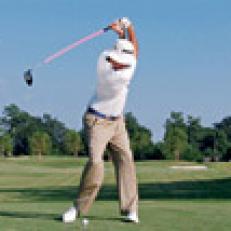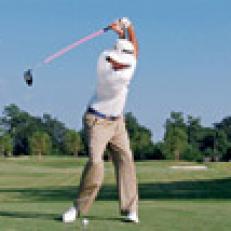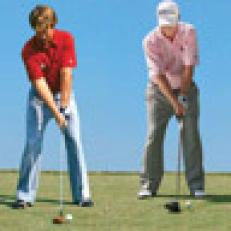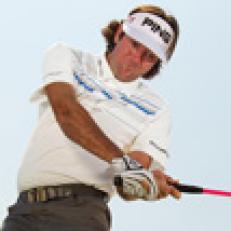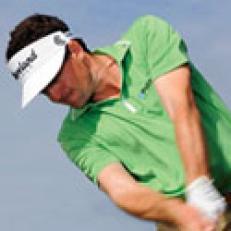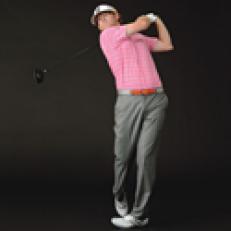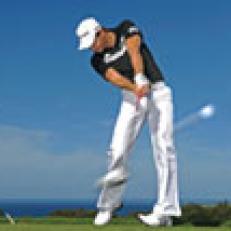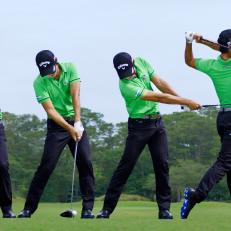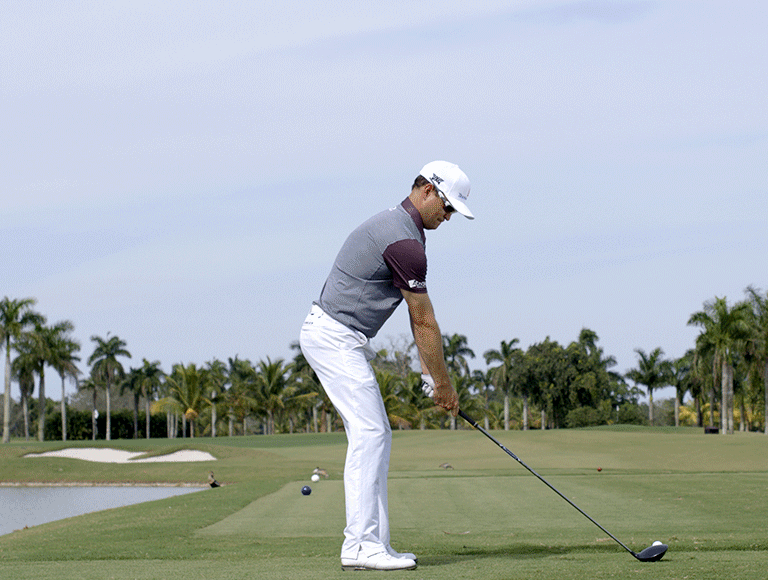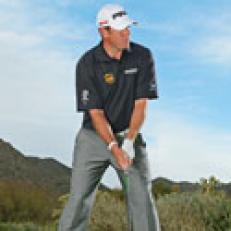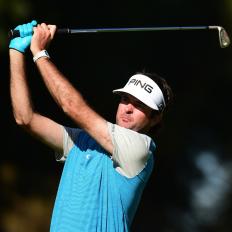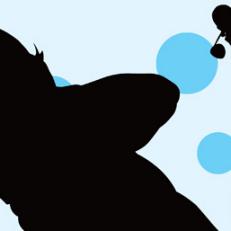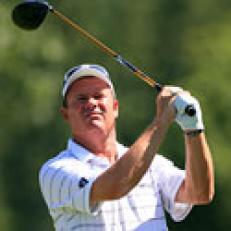Face-OnThis is a strong grip, Bubba's hands turned back, but all power hitters do it. Plus, it's easier to work the ball.Analysis by John Daly, winner of the 1991 PGA Championship and the 1995 British Open.
Face-OnAnalysis by John Daly, winner of the 1991 PGA Championship and the 1995 British Open.
Face-OnLook at this huge stretch off the ball. He's creating a massive arc.Analysis by John Daly, winner of the 1991 PGA Championship and the 1995 British Open.
Face-OnHis swing is upright, which is why his hands get so high. Worked for Nicklaus.Analysis by John Daly, winner of the 1991 PGA Championship and the 1995 British Open.
Face-OnHere's the power move: Hips turned to the ball, back still facing the target.Analysis by John Daly, winner of the 1991 PGA Championship and the 1995 British Open.
Face-OnThe way he straightens his front leg forces his head back so he hits it on the upswing.Analysis by John Daly, winner of the 1991 PGA Championship and the 1995 British Open.
Face-OnAnalysis by John Daly, winner of the 1991 PGA Championship and the 1995 British Open.
Face-OnEverybody talks about his front foot spinning out. How about watching the ball go 350 yards?Analysis by John Daly, winner of the 1991 PGA Championship and the 1995 British Open.
Up-the-LineAnalysis by John Daly, winner of the 1991 PGA Championship and the 1995 British Open.
Up-the-LineAnalysis by John Daly, winner of the 1991 PGA Championship and the 1995 British Open.
Up-the-LineAnalysis by John Daly, winner of the 1991 PGA Championship and the 1995 British Open.
Up-the-LineIf Bubba's like me, when he sees the clubhead out of the corner of his eye, he knows it's time to start down.Analysis by John Daly, winner of the 1991 PGA Championship and the 1995 British Open.
Up-the-LineAnalysis by John Daly, winner of the 1991 PGA Championship and the 1995 British Open.
Up-the-LineAnalysis by John Daly, winner of the 1991 PGA Championship and the 1995 British Open.
Up-the-LineAnalysis by John Daly, winner of the 1991 PGA Championship and the 1995 British Open.
Up-the-LineAnalysis by John Daly, winner of the 1991 PGA Championship and the 1995 British Open.
Down-the-LineI don't hover the clubhead like this, but Bubba likes it as a tension reliever.Analysis by John Daly, winner of the 1991 PGA Championship and the 1995 British Open.
Down-the-LineAnalysis by John Daly, winner of the 1991 PGA Championship and the 1995 British Open.
Down-the-LineAnalysis by John Daly, winner of the 1991 PGA Championship and the 1995 British Open.
Down-the-LineAnalysis by John Daly, winner of the 1991 PGA Championship and the 1995 British Open.
Down-the-LineThe clubhead is lagging behind for a last-second burst before impact.Analysis by John Daly, winner of the 1991 PGA Championship and the 1995 British Open.
Down-the-LineAnalysis by John Daly, winner of the 1991 PGA Championship and the 1995 British Open.
Down-the-LineWhen Bubba's older, he might need to focus more on balance, but right now his coordination is so good, he can just rip it.Analysis by John Daly, winner of the 1991 PGA Championship and the 1995 British Open.
Down-the-LineAnalysis by John Daly, winner of the 1991 PGA Championship and the 1995 British Open.
BUBBA SAYS:LONG AIN'T WRONGLike John just told you, don't listen to the talk about shorter backswings. There's nothing wrong with taking it back as far as your body allows. Just don't exaggerate it. The most important thing is making solid contact. If you hit it off the toe or heel of the clubface, you might be swinging too hard.WITH A KISSIf you can kiss your shoulder at the top of the backswing the way I do, you'll know you've maximized your turn away from the ball. It should feel as if your back is facing the target at the top. This requires a fair amount of flexibility, but I recommend you give it a try.LET IT COME UPYou've probably heard teachers say not to lift your front heel like this. That's why I don't listen to teachers. Letting the heel come off the ground is especially helpful for amateurs who lack the flexibility to make a full turn.
BUBBA SAYS:ALL IN THE RELEASEI won't try to convince you that I haven't rotated my hands a lot here, but the truth is, my strong grip actually reduces the amount of hand action required. Try gripping the club so you can see another knuckle on your left hand (for right-handers) when you look down at address. You'll need less hand action to square the clubface through impact.SKATING AWAYThis might look like an off-balance finish, but it doesn't feel off-balance to me. I suspect my funny finishes relieve pressure on my joints. If my front foot stayed glued to the ground from start to finish, the stress on my knee might lead to problems. I'm not saying copy this move, but staying healthy isn't a bad idea.HIT UP ON THE BALLMost pros hit their driver on the upswing, and you should, too. Teeing the ball high and keeping your head back through impact are the big keys. You want to launch the ball higher with less spin. That's the combo that lets you max out your distance.

